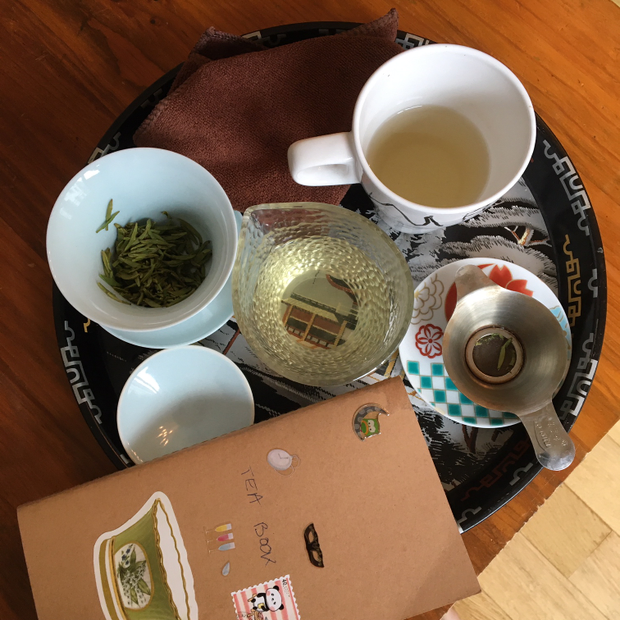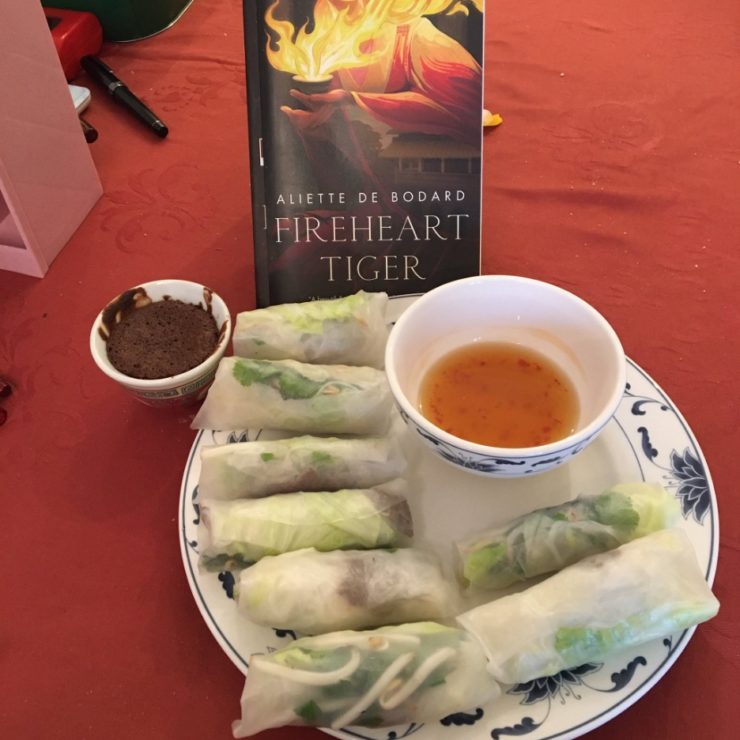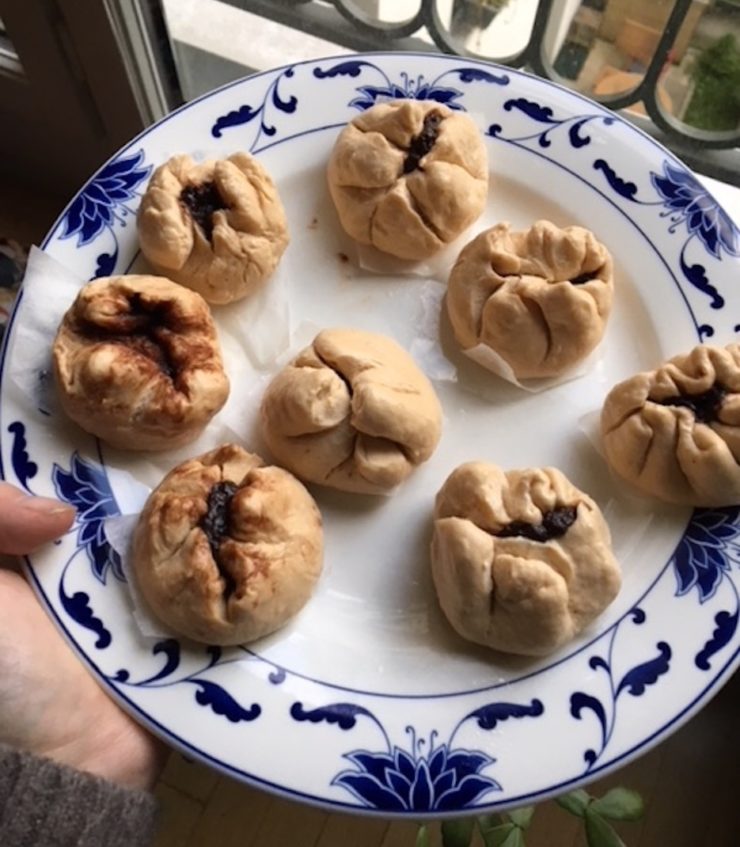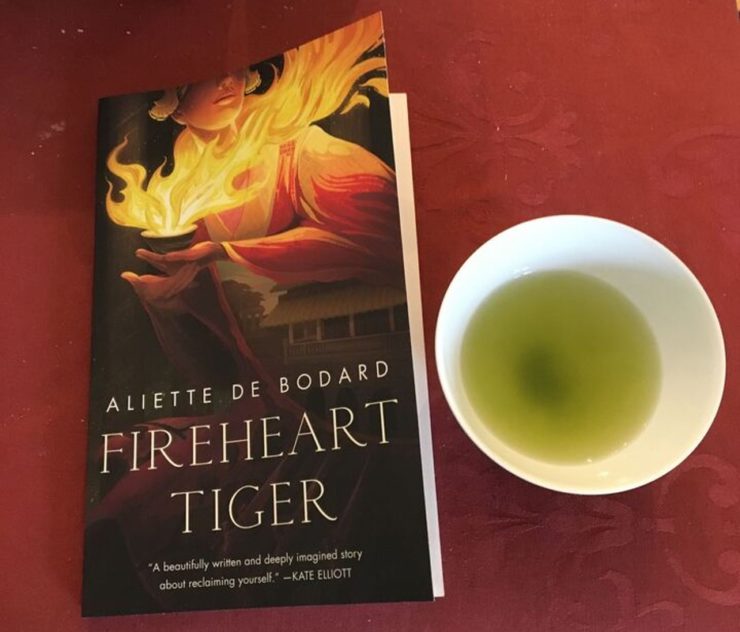Food is often the thing that brings us together, that unites families, communities, and culture. In Aliette de Bodard’s Fireheart Tiger, food and drink play a unique role. Here, the author shares some key moments and recipes from the story that you can make at home to share in the experience. Brew yourself a proper cup of tea and read along!
***
The Proper Tea (trà)

Choosing A Brew
The Empress of Heaven, the Fateful Prosperity Ruler of Bình Hải, stares at the teas. There’s what feels like a myriad of them before her, so many different leaves held in porcelain scoops, a sample of the best that her storehouses have to offer, taken from tight lacquered boxes and displayed for her approval.
Teas.An audience with foreign envoys is a careful thing–not a matter of ritual, but of messages that must be sent. Of reminders of strength, all the more important when Bình Hải is small and beleaguered, and about to enter negotiations for its very survival in a position of weakness.
She will receive the Ephterian envoys in her throne room, with the might of her officials arrayed like the army she doesn’t have. She will serve them tea in beautiful celadon–not the paltry imitations of their former colonisers, but the kiln-fired ones where the porcelain shimmers like dragon’s scales. And she will ask them for the guns and the silver Bình Hải needs to keep existing.
All that remains is to pick the right tea.
“Your Highness.” Long, the eunuch who is her closest adviser, clears his throat. “This one maybe?”
It’s a tea from the highlands near the Hương ruins–a toasted one with leaves rolled like pearls. “No,” the Empress says. “Too rustic.” Too close to the astringent one the sailors keep on their ships, the one country peasants roast on their own hearths. The Ephterian delegation will be reminded of what they were served on the way there.
She fingers the leaves of another tea–long tightly wound spiral leaves, the colour of bark. The aroma wafts up to her: it will be strong and mineral, chestnuts from distant shores. “Not quite.” Too strong, too bold. Too aggressive.
Which leaves…
The last tea in the scoops is smaller, straight leaves: as dark as algae, shot through with glimmers of jade green. It smells of steamed vegetables, and it will brew will be luminous green, smelling of the sea. It’s a Quỳnh tea, from their landlocked trading partners: a statement that Bình Hải has more trading ties than the ones with their former colonisers or the ones with Ephteria. A reminder that they can afford to import such delicate, expensive, beautiful things. The Empress touches the leaves, feeling their sharpness on the tip of her fingers.
“This one,” she says.
***
Brewing tea, gong fu style
Brewing tea is a complex and delicate subject, and the most I can pretend to is passing on what works for me. I brew my tea gong fu style, which means using a high ratio of tea leaves to water, in order to get a very concentrated tea beverage. Brews are successive and each one generally takes more time than the previous one. The leaves are also put straight into their brewing recipient with no filter: this leaves them full space to expand and spread their aroma through the tea.
The three teas the Empress is looking at in the excerpt are a Dong Ding oolong (which she is very uncharitable with!), a yunwu maojian which is typical of Chinese mineral teas, and the last one is a sencha, probably deep-steamed (it’s the deep-steamed which have this luminous green liquor, the other sencha has bright yellow-green).
Buy the Book


Fireheart Tiger
You will need:
- A brewing recipient. I use a gaiwan, a covered Chinese teacup, but you can also use a teapot. Look for something that contains at most 160mL of water. Especially for delicate and high quality tea, brewing in a small amount of water is key to getting the best of the flavour
- 3.5g of tea per 100mL of water. For my 120mL gaiwan I use 4.2g, for my 160ml teapot I use 5.6g. Precision matter in this case: I highly suggest investing in a digital scale.
a filter to put over the tea cup. The filter can also be included in the teapot (they’re generally at the base of the spout). It’s important that this filter doesn’t hinder the full spread of tea leaves in the teapot. If you’re brewing deep-steamed sencha, it’s better to get a teapot with a fine mesh filter included: deep-steamed sencha has terribly small and fine leaves, and they tend to clog everything if you’re not using a fine mesh. - One ore more teacups. Preferably small as it enables the aroma to be more concetrated (my largest cups are 180mL).
- A temperature variable kettle. Black teas aren’t super fussy about temperature, but the green and more delicate oolongs aren’t forgiving of being boiled. The base rule I use is: 70°C for sencha, 80°C for Chinese tea, 90° for oolongs, and then I adjust depending on manufacturer’s instructions.
- (optional) A fairness pitcher, which makes sure that every cup gets the same concentration of tea brew. The bottom of the brewing recipient will hold a stronger brew than the top, which gets visible if pouring into small cups. Pouring into pitcher prior to pouring into the cups helps cool and aerate the tea as well (it will alter the flavour, so you may want to check if you prefer to pour straight into the cups).
What to do:
- Measure out the tea and set it aside
- Set water to boil at the appropriate temperature
- Warm up the brewing recipient by pouring the hot water in it, leaving it for 5s and pouring it out
- Put the tea leaves in.
- If brewing an oolong or darker tea, rinse the leaves by pouring the hot water over them for 5s, and then pouring out the rinse. Skip this stage for green tea.
- Pour the hot water over the tea, leave to brew for the required time. Be careful, brewing times are short!
- Pour through the filter and into fairness pitcher or cup.
- Enjoy!
- Follow the instructions for subsequent brews
Brewing guide:
(These are rules of thumbs, check the specific instructions if they exist.)
- For sencha or deep-steamed sencha (5 brews): 70°C water temperature, 1st brew 45s, +15s for each subsequent brew (so the second brew is 1min, the third brew is 1min15s)
- For Chinese greens (5 brews): either 70°C/1st brew 30s/subsequent brews 30s, or 80°C/1st brew 15s/+5s for each subsequent brew
- For oolongs (9 brews): 90°C /1st brew between 20s and 40s depending on desired strength/+5s for each subsequent brew
Memory food: summer rolls (gỏi cướn)

A Soothing Time
Thanh doesn’t remember Bà Ngoại very well. The Empresss Dowager died when she was six, the only time in her life she can remember Mother crying–’standing in her private chambers, tears streaming down her face and the wings of her phoenix crown shaking with each sob.
But it was Bà Ngoại who taught her to fold summer rolls: how to choose the fillings to get a balance of flavours, how to cut up salad leaves so they don’t pierce the rice paper wrapping, how to roll them into small, compact shapes. And whenever she does that, Thanh remembers a little of her–a perfume of cedar and sandalwood that’s not quite the ones in the pagoda, hands smelling of garlic and chopped shallots, resting on her–the sniff on her cheeks as Bà Ngoại embraced her, a soft amused laughter that always lit a warmth like embers in Thanh’s belly.
Mother judges Thanh and always finds her wanting–too soft, too shy, too pliant to be a princess of Bình Hải. But Bà Ngoại never expected anything more of Thanh than company. When Thanh showed Bà Ngoại her first rolls–sagging, overfilled, the bean sprouts piercing them in multiple places like pathetic swords, Bà Ngoại smiled and said “These are wonderful, child. Let’s see how we can make them better next time, shall we?” And again and again, until they came out right.
Whenever Thanh is upset, she finds refuge in the kitchens. The servants scatter out of her way, unsure of what to make of her. It’s unseemly for a princess to be there, but Thanh–the Princess who Went to the Heart of Winter, the hostage from Ephteria who returned–is odd, after all. She came back with habits and poses from another court, and straddles uncertainly a space somewhere between Ephteria and Bình Hải–neither one nor the other and despised by both.
She’s there now, trying not to think of Princess Eldris of Ephteria. Trying not to think of making love to Eldris in the gardens–of ice-cold lips on her hands, and Eldris’s blue gaze resting on her with possessiveness–with the fondness of someone who’s come halfway around the world for the one she’s always wanted, always loved.For Thanh.
You love me. Don’t you?
This is utterly serious. Think on it, will you?
Thanh doesn’t know what to make of it, of any of it. So she simply holds the rice papers into the water, waiting until they become soft and translucent and pliant. And then lines up, with the same care as she’d line up chess pieces on a board, the fillings: meat, salad, rice vermicelli herbs, soy sprouts. She rolls them tightly, hearing Bà Ngoại’s gentle voice in her head. Gently, child. Just a pinch of rice vermicelli. See how they come together.
She lift up the roll she’s just finished–a perfect cylinder smelling of mint and coriander, with not one thing out of place, and sets it on top of the others in the pile, completing an invisible pattern. Her hands ache for a touch since long gone.
“I wish you were here,” she says, to the silence of the kitchen, and tries, very hard, not to cry.
***
How to Make Gỏi Cuốn
It’s best to think of gỏi cuốn as a giant salad, except this salad happens to be wrapped in rice paper. The classic version is made with pork and shrimp, but you can mix and match based on what you have available. Here I use a marinated lemongrass beef filling that can also be used in other contexts.
You will need (makes about 15 rolls):
- 220g beef
- 160g bún noodles
- 2 shallots, chopped
- 1 tablespoon nuoc mam
- 2 big garlic cloves, chopped
- 1 stalk lemongrass
- 1 tablespoon sugar
- 15 sprigs mint leaves, or to taste
- 15 sprigs coriander, or to taste
- 80g bean sprouts, washed
- rice paper wrappers (bánh tráng)
For the dipping sauce (Nước mắm):
- Basic measuring unit: juice of one lime
- 1 units of nước mắm
- 1 unit of sugar
- 4-6 units of water
- 1 garlic clove, chopped into small pieces
- 1 teaspoon of chilli garlic sauce (I use Lee Kum Kee, which is medium hot, since the point isn’t to take out your taste buds)
How to make:
Start with the dipping sauce:
- Juice the lime
- Heat up 2-3 units of water to 50°C and dissolve the sugar in them
- Mix together the sugar dissolved in water, the lime and the fish sauce
- Add the remaining 2-3 unites of water.
- Add the garlic close and the chilli garlic sauce. Leave to rest at room temperature for 10 minutes.
Marinated meat and vermicelli:
- Make the beef marinade: mix together the nuoc mam, garlic, lemongrass and sugar.
- Cut the beef in thin slices, mix with the marinade, and leave for half an hour (longer if you can).
- On a medium-hot stove, pan-fry the beef until it’s done. Cover, and take away from the stove.
- Pour boiling water on the bún, and mix them with chopsticks until they turn opaque white and are no longer brittle. Drain the noodles and leave them to cool.
- Rinse the mint, coriander and salad.
Making the rolls:
- Take one sheet rice paper, dip into warm water until it becomes supple and translucid
- Lay it flat on worktable
- Put three pieces of the beef at the bottom
- Put two pinches of salad, a pinch of bún, 2-3 bean sprouts
- Put 3-4 leaves of mint and 3-4 leaves of coriander on top
- Fold the rice paper sheet like an envelope over the filling: the bottom first and then the sides
- Roll carefully from the fold upwards into a cylinder, sealing the edges
These can be eaten immediately with the dipping sauce, or kept in a moist teatowel for half a day or so
Heart Food: Steamed Buns (Bánh bao)

A bewildering array of fillings
Of all the things Giang doesn’t understand about humans, the first thing is feelings, and the second is food.
Giang is a fire elemental: she doesn’t eat, or rather she can eat but she doesn’t need to eat the way humans do. She needs to burn. Every hearth and every lantern in the palace calls to her, and she’s part of them in a way she feels but doesn’t quite understand. Food is a startling new discovery: there is so much of it, and so many odd rules about it all.
Presently she’s sitting on the bed in Thanh’s bedroom, and staring at a steamed bun she retrieved from the bamboo basket on the bedside table. “This one doesn’t have an egg yolk in it,” she says, accusingly.
Thanh has just come back from a day of negotiations with the Ephterians. She lays her headdress on the bed: a sleek golden thing with a dragon coiled on top, lifelike in a way that makes Giang uncomfortable. She’s met dragon spirits: they’re as deep and as temperamental as the seas, and whenever they look at Giang, Giang remembers how small and slight she is, how easily her flames can be extinguished. She forces herself to look away from the headdress, and at Thanh.
“Let me see,” Thanh says, smiling. It lights up her entire face: it’s like fire but not Giang’s fire, something that utterly transfigures her and makes her go from exhausted, dark-skinned princess to someone who takes Giang’s breath away. “That looks like sesame,” Thanh says.
The filling is as black as charred wood and as grainy, with a sweet and nutty taste that’s wholly unfamiliar but seems to hit all of Giang’s tastebuds at the same time. “I’m not sure I like that one.”
“Here,” Thanh says, rummaging in the bamboo basket, and pulling another one out. This one has the wrinkles on top of it, and smells… more earthy. “That’s a savoury one.”
Giang eyes it suspiciously. Why do humans go to all this trouble over wrapping food? Thanh break off a piece, holds it to Giang’s lips. When Giang swallows it, it tastes sharp with some kind of steamed vegetables, and with an aftertaste that suggests sweetness but doesn’t overwhelm. “Hmmm,” Giang says.
“Better?” Thanh asks.
Thanh’s fingers still rest on Giang’s lips. Giang can feel the cool suppleness of Thanh’s skin, the warmth of her heartbeat. Something shifts and tightens within her that she can’t quite name as they stare into each other’s eyes.
Food. Feelings.
“Yes,” Giang says, finally. “Better.”
***
How to Make Steamed Buns
Bánh bao is the Vietnamese name for a steamed bun that’s found in many Asian and Southeast Asian countries: pau, siupao, bao are some of the names of the bun that come to mind, and there are plenty more. It’s not complicated, per se, but like all raised dough stuff it requires patience (and some passing familiarity with the art of kneading).
You have the choice of buying the ready made flour mix, which is a very soft and fine flour that’s hard to find elsewhere and will make very soft and creamy buns, or to make your own with all purpose flour and tapioca starch. I’ve found both come out ok, but I’m not super fussy when it comes to how my baos taste.
They can be filled with sweet or savoury fillings (xá xíu, roasted pork, being the one that most readily comes to mind). I’ve offered you a choice of three here.
You will need:
- Dough
- 125g all purpose flour or special steamed bun flour
- 25g tapioca starch (or 25g extra flour)
- 37g sugar
- 2 teaspoons of oil
- ¼ teaspoon of active dry yeast
- 75mL water at room temperature
Black sesame paste filling:
- 50g black sesame seeds
- 3.5 tablespoons oil
- 3.5 tablespoons sugar
Nutella filling:
- 12 teaspoons of Nutella (1 per bun)
Savoury filling:
- 125g minced pork (pork butt if possible)
- 25 g leek, finely chopped
- 2 slices ginger, finely chopped
- 1 tblsp soy sauce
- 2 tsp shaoxing rice wine
- 2 tsp oil
- 1/2 tsp sesame oil
- Pinch of salt
What to do:
For the savoury filling:
- Mix together the pork, the ginger and a pinch of salt until well combined.
- Add the wine, the sesame oil, the soy sauce, and then the leek and the oil.
Sesame filling:
- Lightly toast the sesame seeds in a dry pan on medium heat until fragrant (be careful, over-roasted sesame is very bitter, so err on side of caution).
- Grind them with a mortar and pestle, or blitz the seeds, the oil and the sugar in an appropriate food processor until you get a paste (I’m actually super lazy and I just pound lightly—it makes a crunchier paste).
- Put it in the fridge for 30 minutes until it hardens.
Ready-made dough: follow the instructions (I used about ⅓ of the packet for 11 buns)
If not, follow the recipe below:
- Reactivate the yeast in 38°C warm water, leave to stand for 10 minutes. Meanwhile, mix the flour, tapioca starch and sugar. Add the yeast mix and the oil, mix well. Then gradually add the water until you get a sticky but relatively firm dough (you may not need all the water; also, whatever water you used to re-activate the yeast needs to be deducted from the total of the 75g water).
- Stretch and fold 5 times at 5 minutes interval, until you can stretch the dough enough to see light through it. Then leave to rise for 2 hours (if you live in cold climes put it in a 24°C oven because mine definitely wasn’t risen at the 2 hours mark). Stretch and fold technique: here.
- Gently deflate the dough. Roll it into a cylinder and cut into bits of 25-30g each (you can cut into 12 pieces, I find it’s more accurate if you have an electronic scale). Cut up little squares of baking paper to put under each bao.
- Roll each piece using a rolling pin on a floured surface until you have a large disk. Put one tablespoon of chosen filling in its centre (1 teaspoon if using sweet), then pleat and fold if using savoury (pleating video: here). For the sweet ones (or if pleating is too hard), you have the option of simply wrapping the dough over the filling to make a ball.
- Put on baking paper and in steamer basket.
- Leave the buns to prove for 15-30 minutes. Then steam for 10 minutes. Open the steamer to remove excess water that’s accumulated under the lid, and steam for another 10 minutes. Leave to stand for 5 minutes until they’re firm to the touch.
They can be frozen and reheated by steaming, or kept in the fridge wrapped in clingfilm.
***
Fireheart Tiger is available from Tordotcom Publishing.
Read an additional excerpt here.
Aliette de Bodard lives in Paris, and writes speculative fiction: her short stories have garnered her two Nebula Awards, a Locus Award and two British Science Fiction Association Awards. She is the author of the Dominion of the Fallen series, set in a turn-of-the-century Paris devastated by a magical war, which comprises The House of Shattered Wings (2015 British Science Fiction Association Award), and its standalone sequel The House of Binding Thorns (2017 European Science Fiction Society Achievement Award).










